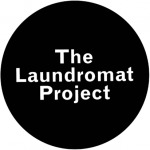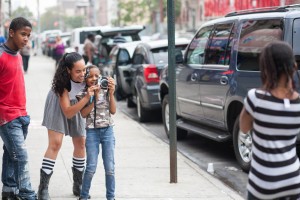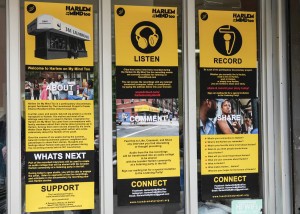Up Close with Arts Entrepreneurs: The Laundromat Project
Big Ideas | Tips and Tools | Arts Business | Artists and Members
by Jason Tseng, Community Engagement Specialist at Fractured Atlas
Fractured Atlas recently recognized The Laundromat Project as an honoree of the 2015 Arts Entrepreneurship Awards for their pioneering work in connecting communities to their creative potential. We interviewed Executive Director Kemi Ilesanmi to find out just how The Laundromat Project is able to use artists to engage people with art when they least expect it.


What is The Laundromat Project?
The Laundromat Project is an arts organization that has been around for about 10 years, and our mission is to amplify the creativity that already exists in neighborhoods, fueled by the belief that arts, culture, and creativity help create community, solve problems, and connect people together in those contexts. Our mission happens through working in community spaces such as laundromats, libraries, parks, and the like. These are public or semi-public spaces that get a variety of people coming through the space who may be strangers even though they live in the same community.
What is it about laundromats that make them such good spaces for engaging the public?
The initial attraction was that laundromats, especially in a city like New York, which has about 2,700 or so laundromats, are actually spaces where a whole variety and diversity of people come through. It’s a multigenerational, multi-racial, multi-class space. It’s a space where all kinds of people come together, yet they’re not necessarily connecting with each other; you’re wearing your headphones, you’re focused on doing your own business, taking care of your own laundry. It’s also untapped time: you’re watching your clothes spin around, but there’s not that much else you can do. So people are often open to alternatives of how to use and be engaged during that time.
Are people ever wary or suspicious of you or your team when you’re in those spaces? How do you get buy-in from participants or the local businesses you’re working with?

We work citywide around New York City but anchor ourselves in three particular neighborhoods: Harlem, Hunts-Point/Longwood, and Bed-Stuy. We work on two sides of one coin. We work with artists directly. We commission art and have artists-in-residence that work in laundromats or other kinds of community spaces and make art. They make art that is socially engaged, which is about being in connection with one’s neighbors and also being connected to issues that are socially relevant to the community with which they are working. So they have had film festivals, portrait studios, yoga studios, oral history projects, and just a real range of amazing projects over the years.
We also have a training program for artists who want to learn how to do this work more deeply, and be connected to other artists across disciplines who are doing this kind of work. We are creating artists as leaders within their communities, and empowering artists as neighbors. The other side of that coin is that we work directly with everyday people who may or may not identify as artists. They might be students, people who work or do business at the laundromat, or just neighbors. So we have community arts education workshops in and around laundromats.
We work with artists to give creative walks of neighborhoods. We have festivals that engage and celebrate neighborhoods. And we have afterschool programming. One of the things we’ve learned from working in laundromat spaces (although that’s not the only kind of community space in which we work) is that the power of being present is so key to our work.
Oftentimes, the first time our artists work in one of our laundromats they are not immediately engaged by residents — people might not be comfortable or they might be in a rush, for example. But if the artist is there several times a week, or every weekend, over a period of time, people become more open to engaging because you’re in a neighborhood setting. So that’s something we’ve learned about the power of being present. It is about being open, flexible, and adaptable. We’re dealing with human beings. This isn’t about doing work in a studio where an artist is only answering to themselves. They actually are answering, being accountable to, and connecting directly to people.
We had an artist, Aisha Cousins, for instance, who did a really amazing project where she was asking neighbors to create a streetscape along Malcolm X Boulevard in Bed-Stuy that would create a timeline of Malcolm X’s life. It was a metaphor about evolution and life. Initially she wanted people to take Malcolm X’s various names over his lifetime — Detroit Red, Malcolm Little, etc — and figure out how to change the streetscape with that as an inspiration. But she realized that isn’t being very open and is dictating the terms and the final product. So she instead asked neighbors to come up “Who would you like to name this street after? Who matters to you in your life in your culture, in your sense of self?” So that was a very different process, but still satisfied her initial idea of re-engaging people in their sense of place and cultural investment and ownership of space.
In regards to the laundromat owners, that’s also something that’s evolved over the years. We’ve learned as an organization working with various artists that they need to select their own laundromats. We don’t dictate that because it’s about being engaged in one’s own neighborhood. For example, Bed-Stuy is huge. There are so many laundromats to choose from. So what happens oftentimes, the artist wants to select a laundromat that they are familiar with and that satisfies the needs of their project.
We had one artist, for example, who was doing a yoga project. She needed a laundromat that had a large interior space that was available, which is not very common. But it turns out the laundromat that she uses, actually did have that, which was fantastic.
In talking to laundromats, the biggest obstacle is often getting to the owner. Often the attendants don’t have the power to say yes. So it takes time and cajoling to connect with the owner or the decision maker, who often times doesn’t work in the space. More often than not, they are open to it. It really depends. Some of our laundromat owners live in the neighborhood, or live above the shop, so they are otherwise invested in the community and want to see positive things happening in their space. They might be interested because our work might connect with young people. Some really recognize it as a business opportunity, as something that sets them apart from other laundromats in the neighborhood. It’s all about getting to the right person and what’s the entry point to have a conversation that’s about mutual benefit for both of us.
You mention that you work in those three anchor communities. How did you decide on those neighborhoods?

We were incorporated 10 years ago. The founder, Risë Wilson, had this idea in her belly in the late 90s but we actually incorporated in 2005. At the beginning our residency projects were citywide and even in New Jersey and Philadelphia, so this anchoring is fairly recent, within the past three years. During our 2012 strategic planning process, we decided that we wanted to be true to our theory of change, which privileges building neighborhood relationships over time. Because we were initially following the applications, we wouldn’t know where we were working until the applications came in and thus, we weren’t able to build relationships over time.
In Harlem and Bed-Stuy, we received artist residency applications every single year. Those two neighborhoods just really made sense and seemed organic to the population of artists and neighbors that we were interested in working with. Hunts Point was chosen as the third. It was a strategic discussion regarding how many neighborhoods we wanted to engage with on an ongoing basis. One seemed too drastic a cut. Two didn’t feel robust enough. Three seemed like the magic number where you could have cross-pollination and connect across these neighborhoods. It was a subjective decision, but made sense for us.
We ended up choosing Hunts Point because while we were in the decision making process, we had just been invited to work in that neighborhood by a local organization and we had also just received a large grant to build more programs in that neighborhood. It became a very natural third place. But it also meant that it was the newest place. It actually has been nice to have that mix of Bed-Stuy, where the idea first originated; Harlem being an organic choice through our first seven or eight years of activity; and Hunts Point being a new neighborhood that we’re just learning more about.
How do you measure success as an organization? What point could you that you have accomplished your goals in a neighborhood and perhaps move one or expand?
This is definitely long term work, so the impact is about developing creative community leaders. Those are artists as well as everyday folks who we believe all have rich creative capacity regardless of whether or not they choose to identify as artists. For us, success would look like having, over time, artists and their neighbors working together to create the communities that they want to live in.
They are visioning their neighborhoods together. They are having difficult conversations and are using creativity to fuel all that work. They are both individually and collectively building community leadership with creative tools. We view creativity as a renewable and never-ending resource people have. It could look like a bunch of different things. We are interested in who and how we are engaging with the public. We’d love artists to join their community boards, for instance. We want artists to find new ways to engage with their communities. Are young people in our afterschool programs thinking in new ways about their communities and engaging cross-generationally to make change in their communities?
We’re building community across differences of all sorts. All that work takes a while. A lot of our artists start a project in one of our residencies and then continue to build the project afterwards. For instance, one of our artists started a community music project using boom boxes in 2007, but after the project was officially concluded, he continued to build out that project that’s now being exhibited nationally. We had a yoga project that has continued every summer in that same laundromat. We had an amazing project with a community garden in Hunts Point last year, and they’ve invited us back to do that program year round.
How do you make sure you have good feedback loops? How do you know which feedback is helpful vs unhelpful or ignorable?

We really do try and build feedback into our programs in a very structured way and at multiple points in the process. We have evaluations that happen for each artist training workshop as well as at the end of the program, and really incorporate that information. The Create Change residency program has evolved in direct relation to the feedback we’ve received from past participants. The feedback is varied so we have to make a decision as a staff and as a board around how we respond to feedback. Everything from the time that we hold our workshops to how we engage with artists in the community are open to discussion.
For the younger students with whom we work in our high school program, we’ve worked with them to help them to select their own teaching artists. So they were actually invested and helped choose who would lead the program.
For community residents, take that community garden I mentioned earlier, they have a lot of different projects that they’re working on from Halloween parties to wellness workshops to job trainings. Those are not necessarily things that are in our particular wheelhouse, but we can listen to them and help connect them to resources.
In the mean time, we’re keeping a pulse on what the community cares about, and that includes topics beyond the arts. Our artists are holding art workshops every week so they are able to keep their ears close to the ground. We attend community board meetings. We are working as a staff to understand what is going on and share with each other so that we are collectively aware of the issues at hand.
There is an uneasy history between arts communities and poor communities/communities of color around gentrification and involuntary displacement. How do you address that history and navigate that aspect of the work?
It’s a conversation that we are very pro-actively interested in being a part of. It’s one that the neighborhoods we are working in, particularly Harlem and Bed-Stuy, are at the forefront of that conversation. We approach this with the framework that artists are neighbors and members of communities. Some of what they bring is the ability to vision, be resourceful, act as connectors and translators. We’re very much trying to shift them out of the frame of being the vanguard of gentrification and rather being in collaboration and cooperation with neighbors.
So that’s why I would say that for us, signs of success are artists who want to deeply engage with communities, like joining community boards, attending neighborhood meetings, etc. We have a community mapping exercise that we ask them to participate in about their own neighborhoods. It’s very empowering for them to define who the community leaders and resources are in a particular neighborhood.Our artists consistently say that is the best part of their engagement with us.
About Fractured Atlas
Fiscal sponsor, fundraising platform, educational resource, advice from a staff of experienced artists & creatives. We’re rooting for you!


